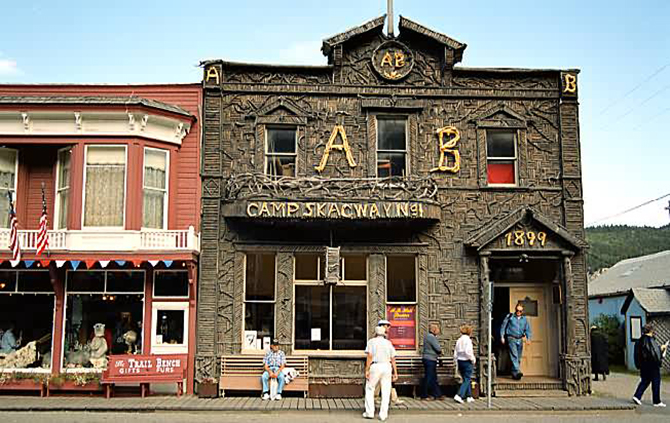
Skagway, Alaska
Explore Alaska with our driving tour or rail/drive expedition, both highlighting the allure of Skagway. Whether by road or rail/road combo tour, discover the breathtaking beauty of Alaska with seamless itineraries that showcase the stunning landscapes, wildlife, and cultural heritage of this picturesque region.
History
These early prospectors endured unspeakable hardships. The windswept summit of the Chilkoot Trail was so steep that the last 1,500 steps were chiselled out of solid ice. Day and night an unbroken chain of men four miles long crawled across the summit. Tlingit Indians earned as much as one dollar an pound packing supplies. In 1898 a 14-mile, steam-operated tramway was built which eased the burdens of those able to pay. Perhaps the greatest inhumanity on the White Pass Trail was suffered by the wretched packhorse. Over 3,000 animals used to cross the trail perished. The animals plunged off the trail and died in tangled masses, or crumpled in exhaustion, only to be trampled into the mud.
When gold strike stories about millions in loose gold began filtering out of the Klondike, every adventurer, gambler and crook in Canada and the United States headed north. Unbridled lawlessness and terror characterized early-day Skagway. The most notable criminal in Skagway was Soapy Smith, a suave, Leadville-Denver trained bunko man. Soapy's band of crooks cardsharks and cutthroats literally ran Skagway.
In 1898 a railroad right-of-way was blasted through the mountains, and in 1899 the White Pass & Yukon Railway was completed to Lake Bennett, 40 miles away. A year later saw the completion of the 110-mile railroad to Whitehorse. The perilous Chilkoot Trail was rapidly abandoned in favor of the railway, and Dyea became a ghost town almost overnight. In 1899, news of a gold discovery on the Bering Sea sparked a second stampede to Nome, and the Gold Rush of '98 died almost as suddenly as it had begun. Skagway's population dwindled to 800. The town lay dormant for almost half a century until the Second World War saw the building of the Alaska Highway. Once again Skagway sprang to life, this time as the terminus of the historic White Pass & Yukon Railway, which supplied the materials to build a highway. Visitors from around the world have replaced gold seekers in the meantime. Most of the town's permanent residents work in the curio shops, hotels, stores, bars and cafes housed in the restored false-front buildings, which line the main street. The privately owned White Pass & Yukon Railway carried visitors and vehicles on a 110-mile mountain-and-tunnel track between Skagway and Whitehorse until 1982, when the railway shut down. It was reopened in 1988 and has become one of the premier visitor attractions in the north.
White Pass Yukon Railroad
The WP&YR climbs almost 3000 feet in just 20 miles and features steep grades of up to 3.9%, cliff-hanging turns of 16 degrees, two tunnels and numerous bridges and trestles. The steel cantilever bridge was the tallest of its kind in the world when it was constructed in 1901. The 110 mile WP&YR Railroad was completed with the driving of the golden spike on July 29, 1900 in Carcross Yukon connecting the deep water port of Skagway Alaska to Whitehorse Yukon and beyond to northwest Canada and interior Alaska.
White Pass & Yukon Route became a fully integrated transportation company operating docks, trains, stagecoaches, sleighs, buses, paddlewheelers, trucks, ships, airplanes, hotels and pipelines. It provided the essential infrastructure servicing the freight and passenger requirements of Yukon‚s population and mining industry. WP&YR proved to be a successful transportation innovator and pioneered the inter-modal (ship-train-truck) movement of containers.
The WP&YR suspended operations in 1982 when Yukon's mining industry collapsed due to low mineral prices. The railway was reopened in 1988 as a seasonal tourism operation and served 37,000 passengers. Today, the WP&YR is Alaska‚s most popular shore excursion carrying over 300,000 passengers during the May to September tourism season operating on the first 40 miles (Skagway, Alaska to Bennett, B.C.) of the original 110-mile line.
White Pass Summit Excursion - This threehour, forty-mile round trip climbs from tidewater at Skagway to the summit of the White Pass - a 2,865 feet elevation! The fully narrated tour features two tunnels, sky-high trestles, cascading waterfalls, historic sites and spectacular scenery! You’ll ride in comfortable restored and replica coaches pulled by vintage diesel locomotives. Experience this unique railroad that symbolizes accomplishment in adventure and pioneering – of triumph over challenge.
Lake Bennett Excursion - Travel by vintage diesel or with Engine No.73, our 1947 Baldwin steam locomotive on an 8 1/2 hour, eighty mile round trip adventure 20 miles beyond White Pass Summit to remote and historic Bennett, British Columbia -- end of the Chilkoot Trail. During the two- hour layover, participate in a walking tour with a Park Historian, explore the area's artifacts and tour the historic displays in our 1903 train station. Fare includes box lunch and photo

